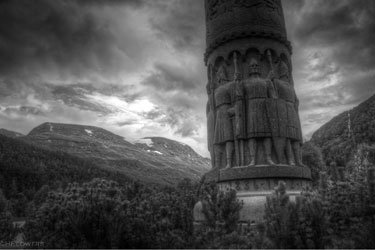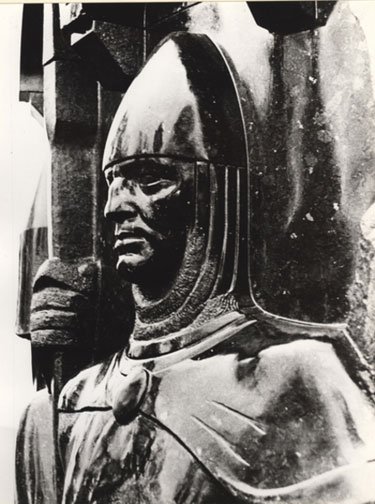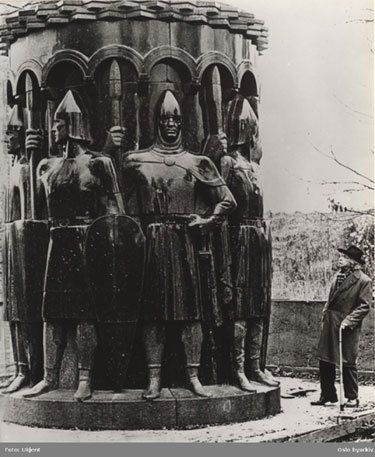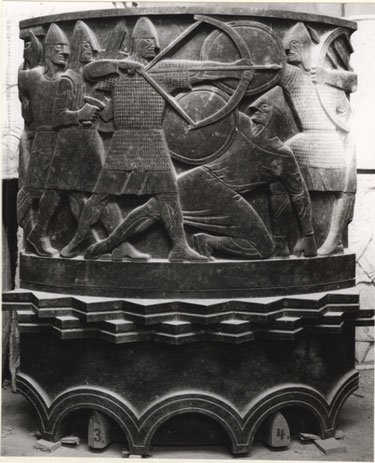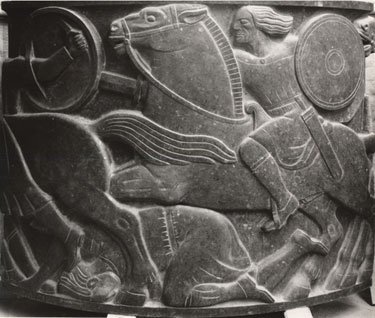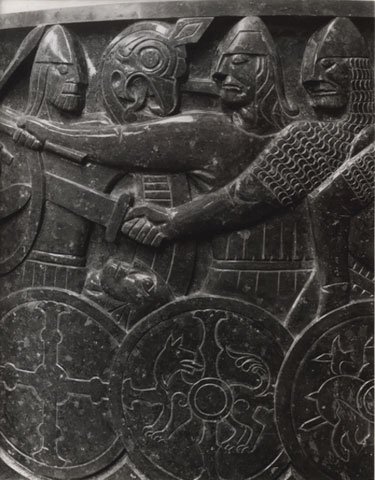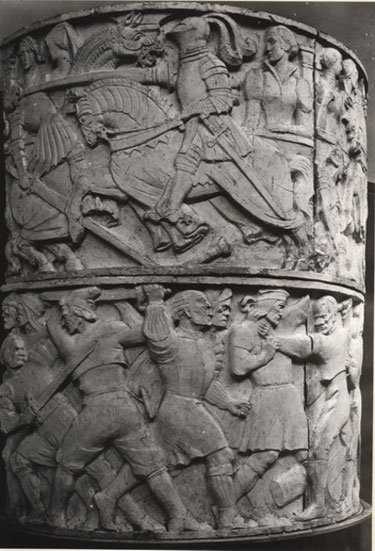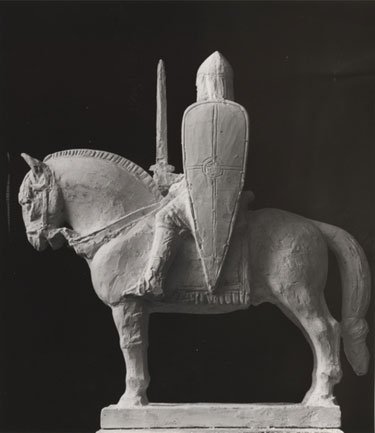Category Archive 'Sculpture'
15 Aug 2016


Portonaccio Sarcophagus, 2nd Century A.D., Museo Nazionale Romano
Kuriositas profiles an exceptionally spectacular ancient sculpture featuring particularly realistic and fine battle scenes:
It was discovered in 1931 near Via Tiburtina, in the eastern suburbs of Rome. Its front depicts a symbolic picture of a battle which is on two levels. The carving remains to this day an incredible achievement – the dark and light contrast beautifully to produce a veritable chiaroscuro effect. This skill involved was superlative.
The sarcophagus was probably used in the burial of a Roman general who was closely involved in the campaigns of Marcus Aurelius. He is seen on the front of the sarcophagus, frozen forever in a charge against his enemies. Yet the face of the high ranking officer for which the sarcophagus was intended is left blank.
It is thought that it was left blank with the intention of the sculptor creating a death mask of the general in that position. Yet perplexingly it has been left unfinished and we can only guess at the reasons for that. We will never know if some form of shame descended on the general before his death or why it was his family or friends decided that he was to be left nameless and faceless for eternity.
Certainly it was not for expediency or money. This sarcophagus would have been incredibly expensive to create and would probably have taken over a year to create. Plus the rest of it (and thus his reputation) was left intact. You can see his troops laying in to their barbarian enemies with gusto. Some are already on the ground, others apparently beg for his mercy. …
The military insignia which can be seen on the upper edge of the casket allows us to try to figure out the identity of the man. It shows the eagle of the Legio IIII Flavia and the boar of the Legio I Italicai. Historians who have studied the casket have pointed towards Aulus Iulius Pompilius. He was an official of Marcus Aurelius who was in control of two squadrons of cavalry which were on detachment to both legions for the duration of the war against the Marcomanni (172-175AD).

Portonaccio Sarcophagus, 2nd Century A.D., Museo Nazionale Romano
08 Jul 2016

Photographe anonyme. Atelier de sculpteurs, vers 1900
21 Nov 2015

A Greek Late Archaic- maybe Etruscan – Bronze male siren.
Who knew that there were male sirens?
via Belacqui.
12 Nov 2015
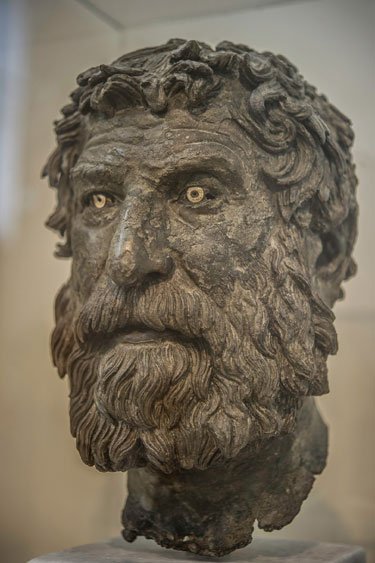
Bronze portrait of a philosopher recovered from the Antikythera shipwreck (crafted circa 240 BC)
Am I mistaken, or did somebody insert a pair of cartridge bases for the eyes?
23 Dec 2014
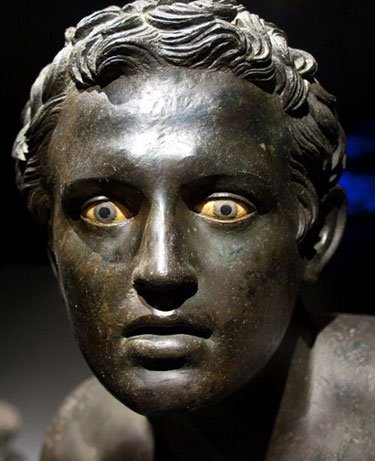


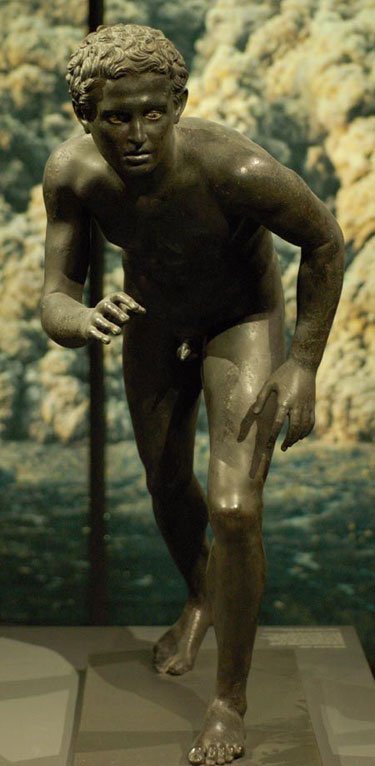
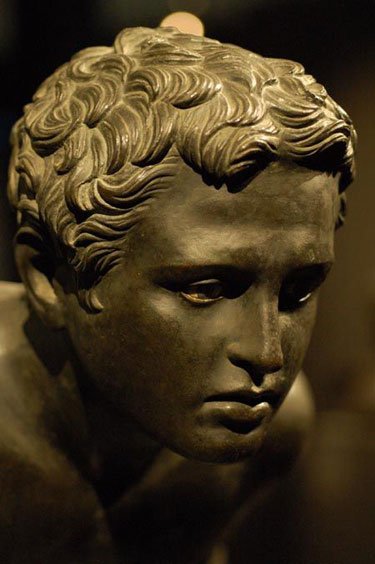
Statue of a athlete.
Bronze. Roman copy of Greek original of the 4th century BC from the school of Lysippos.
Inv. No. 5626.
Naples, National Archaeological Museum.
Hat tip to Ratak Monodosico.
03 Nov 2014


Gillian Wearing, A Real Birmingham Family, 2014, Library of Birmingham
Ikon Gallery commissioned and raised £150,000 in funding from a variety of public and private sources for a monument sculpted over four years by Turner-Prize-winner Gillean Wearing for installation in front of the Library of Birmingham.
Titled “A Real Birmingham Family,” the life-sized bronze sculpture was unveiled last Thursday. The statues are of two real, mixed race, unwed female Birmingham residents, Roma and Emma Jones, with their sons Kyan and Shaye. Emma is depicted 8 months pregnant with her second son Isaac.
The Jones sisters were chosen specifically to represent the 21st Century Birmingham family.
“A nuclear family is one reality but it is one of many and this work celebrates the idea that what constitutes a family should not be fixed.†said sculptor Gillian Wearing.
“Being mixed race, we feel at home here as it’s so diverse and multicultural. As a result, we believe the mixed-race population in Brum will only increase.” said the Jones sisters.
Birmingham Post
Daily Mail
Telegraph
————————–
Monuments are not typically erected, of course, to living people, but obviously the Jones sisters qualify for one on the basis of being photogenic representatives of multiculturalism (what used to be called miscegenation) and unwed motherhood.
Birmingham’s community of fashion, of course, in celebrating the Jones sisters and their bastards is really celebrating the death and replacement of the white Anglo-Saxon British nation by a new racially mixed Britain composed of persons of color and the death of Christianity and European Civilization and its multicultural replacement.
22 Sep 2014



Sigiriya, built by King Kassapa I (477–95), Sri Lanka.
Hat tip to Madame Scherzo.
17 Sep 2014

Displayed in the Saint-Étienne church in Bar-le-Duc, France is the figure of René de Chalon, Prince of Orange. The prince died at the young age of 25 during the siege of Saint-Dizier in 1544.
Rather then memorialize him in the standard hero form, his wife requested (or René himself requested, or possibly both) that he be shown as “not a standard figure but a life-size skeleton with strips of dried skin flapping over a hollow carcass, whose right hand clutches at the empty rib cage while the left hand holds high his heart in a grand gesture.â€
Hat tip to Hello, Tailor via Leah Libresco.
12 Feb 2014


It seems that, either on land in Gaza or under the sea nearby, last summer, some ignorant and greedy barbarians came into possession of an unusually intact and highly artistically significant Hellenistic bronze statue of Apollo. Reports differ, but apparently the priceless statue was briefly being offered on Ebay for $500,000, probably only a fraction of its actual value. Its finder, we are told, chopped off a few fingers for testing, thinking that the statue might be gold. Police representing the Palestinian authority, Hamas, subsequently seized the statue, and it has disappeared.
We can only hope that the nearby civilized state of Israel will take steps to secure possession of this important art object on behalf of the rest of the nations of the West.
Businessweek, January 30th: The Apollo of Gaza: Hamas’s Ancient Bronze Statue
The Guardian, February 10th: ‘Priceless’ bronze statue of Greek god Apollo found in Gaza Strip — Hamas officials seize statue after it appears on eBay — Doubt cast on fisherman’s claim to have found item in sea
Businessweek, February 10th: New Details Emerge in Mystery of Bronze Apollo Held by Hamas
The Verge, February 11th: Ancient statue of Greek god Apollo discovered in Gaza strip
Hat tip to Karen L. Myers.
23 Nov 2013

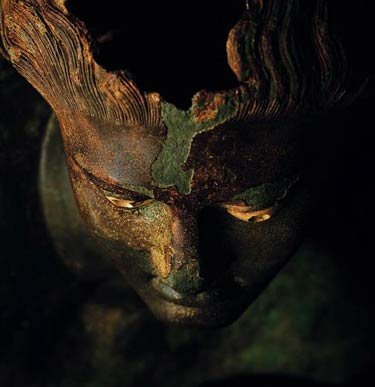
Dancing Satyr of Mazara del Vallo, fourth-century B.C., Greece
Wikipedia:
The over-lifesize Dancing Satyr of Mazara del Vallo is a Greek bronze statue, whose refinement and rapprochement with the manner of Praxiteles has made it a subject of discussion.
Though the satyr is missing both arms, one leg and its separately-cast tail (originally fixed in a surviving hole at the base of the spine), its head and torso are remarkably well-preserved despite millennia spent at the bottom of the sea. The satyr is depicted in mid-leap, head thrown back ecstatically and back arched, his hair swinging with the movement of his head. The facture is highly refined; the whites of his eyes are inlays of white alabaster.
Though some have dated it to the 4th century BCE and said it was an original work by Praxiteles or a faithful copy, it is more securely dated either to the Hellenistic period of the 3rd and 2nd centuries BCE, or possibly to the “Atticising” phase of Roman taste in the early 2nd century CE. A high percentage of lead in the bronze alloy suggests its being made in Rome itself.
The torso was recovered from the sandy sea floor at a depth of 500 m (1600 ft.) off the southwestern coast of Sicily, on the night of March 4, 1998, in the nets of the same fishing boat (operating from Mazara del Vallo, hence the sculpture’s name) that had in the previous year recovered the sculpture’s left leg. …
Restoration at the Istituto Centrale per il Restauro, Rome, included a steel armature so that the statue can be displayed upright. … [I]t is on permanent display in the Museo del Satiro in the church of Sant’Egidio.
Via Ratak Monodosico.
24 Aug 2013

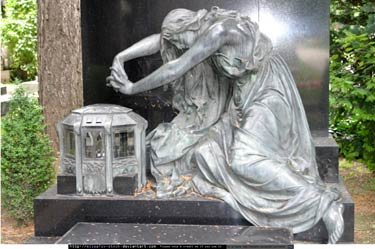
Female sculpture from Zentralfriedhof Cemetery, Simmering, Vienna (click on picture for larger image)
My curiosity is insatiable once provoked, and I’ve just wasted more than a hour trying to figure out whose memorial this very charming statue ornaments, and what is intended by the image of a classically-draped Bernini-esque female figure, kneeling, long hair hanging down, wringing her hands over a peculiar Art Noveau jewelry box or miniature model of a theater. Are we to take it that the soul or anima of the deceased is housed in this rock-crystal-windowed casket and the lady is imploring for it to come back to life?
A statue of this quality and interest is bound to be photographed more than once, and sure enough, I found more details at least, here and here. But none of the photographers can be bothered to identify the deceased party being memorialized, the sculptor, or what exactly is supposed to be going on. Imagine my frustration.
Via Fred Lapides (who means to say “Memento Mori”).
/div>

Feeds
|





